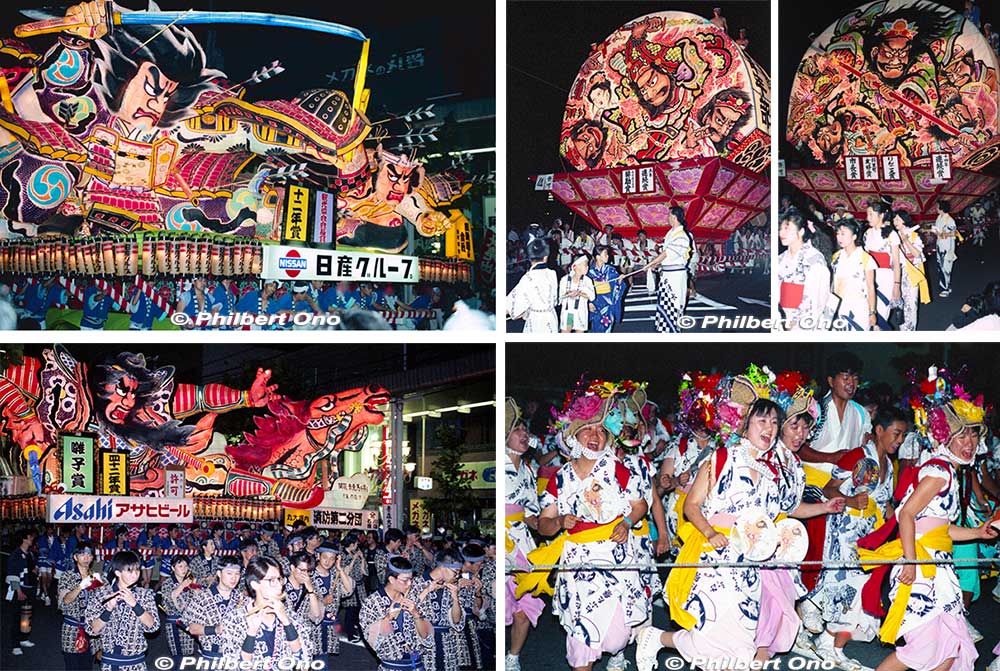
Aomori Nebuta Matsuri is one of Japan’s most famous summer festivals and one of my all-time favorites. Held for a few days in early August, it’s an evening parade of huge paper lantern floats sculpted and painted as legendary, fierce-looking figures (left photos). They are complemented by a bevy of musicians (lower left photo), taiko drummers, and hopping dancers called “haneto” (lower right photo). Really awesome, both sight and sound.
Nebuta Matsuri is perhaps the biggest of the Big Tohoku Summer Festivals held in early August. Since the festivals are held almost the same time for several days, it’s possible to see all or most of them on a single trip if you can spare a week or so in the area. There’s Sendai Tanabata Matsuri, Akita Kanto Matsuri, Yamagata Hanagasa Matsuri, and Morioka Sansa Odori. It’s a busy but fun schedule to travel to a different city almost every day to see all these festivals. Visiting Hakodate in Hokkaido is another worthy side trip from Aomori via the Hokkaido Shinkansen going through the undersea tunnel.
In 2020, Nebuta Matsuri and the other Tohoku summer festivals were canceled due to the pandemic. However, for 2021, they first decided to hold the Tohoku summer festivals while implementing some changes to reduce the Covid risk. This was great news to see major festivals finding ways to cope with the Covid crisis instead giving up and accepting defeat.
After a year of canceled festivals in Japan, organizers are realizing how a canceled festival can bring much trauma, sadness, and economic blow to the community. It’s high time to adapt to and overcome the pandemic. While the virus has been mutating to adapt to us, we humans can also adapt to resist or overcome it. (Update: As of June 2, 2021, sadly, they have decided to cancel the Nebuta Matsuri in summer 2021.)
Nebuta Matsuri is normally held annually on August 2 to 7 in the city of Aomori, while a sister festival called Neputa Matsuri is held on August 1 to 7 in nearby Hirosaki (upper right photos). You can see both, but you’ll have to lodge overnight in Hirosaki to see Neputa. Nebuta and Neputa are similar, but there are major differences especially in the floats. As you can see, Neputa floats are mainly fan-shaped and two-dimensional instead of sculptural like Nebuta.
There are many fascinating aspects about the festivals. How it originated, how the huge floats are handmade and painted every year, the legendary figures depicted, the artists who paint them, and the festival itself.
Preparation for building the large Nebuta floats begins soon after the preceding Nebuta Festival ends. The Nebuta artist conceives the idea for the new Nebuta float, makes sketches of the design, receives approval from the sponsor, builds a framework of steel wiring and wood, assembles all the parts together in a large temporary storehouse, pastes washi paper on the wire frame to create the paper lantern sculpture, paints the paper lantern, and mounts the sculpture on a wheeled platform. It takes months to build a Nebuta float.
The Nebuta floats are made in a Nebuta tent village (Rasse-land) next to the ASPM triangular building near the waterfront. The public can drop by and see the floats being built. By May, Nebuta artists are busy assembling the different parts of the huge floats. The paper sculpture’s hands, arms, body, head, etc., that were constructed separately are put together. Numerous light bulbs and lights are strategically placed inside the lantern frame so that the shadow of the wood pieces is not cast outward.
The tedious task of pasting thousands of washi paper sheets on the wire frame is done by highly-skilled housewives. About ten of them work on one Nebuta, taking about 10 days. A toothbrush is used to apply glue on the wiring and the paper is pasted and cut. Extra care is taken when the figure’s face is papered.
The giant white paper sculpture is brought to life by a Nebuta artist who paints it all by himself. When painting the face, very special care is taken. If he makes a mistake on the face, the paper is torn away and new sheets are pasted on. The very last thing painted on the Nebuta are the eyeballs. They give the sculpture its soul. Nebuta artists are not paid much. It’s really a labor of love. They are a rare breed.
The large Nebuta floats can cost 10 to 20 million yen to build, and they usually have a corporate sponsor whose name is prominently displayed on the Nebuta float.
Each large Nebuta float is accompanied by musicians, taiko drummers, and many distinctly-costumed dancers called haneto. They jerk and hop all over the road while shouting “Rasse, Rasse, Rassera!” They also wear small bells, so it’s always jingling. You can also join in the fun, but you have to rent or buy a haneto costume (for around ¥10,000). In 2021, haneto dancers can still shout “Rassera-rassera!” but must wear a mask. They must also register to join in as haneto since there will be a limited number of them allowed. There will be only 17 large floats this year since five large floats have pulled out. (Sadly, the festival was been canceled in 2021.)
The Nebuta festival route is near JR Aomori Station. The crowd is greatest near the train station, but sparse further away. Lots of drumming, music, and revelry.
During the day, the large Nebuta floats are stored in the Nebuta village open to the public.
In case you visit Aomori when there’s no Nebuta Matsuri, visit the Nebuta Museum Wa Rasse near JR Aomori Station. You can see a few real Nebuta floats and even try pasting washi paper on a float. ![]()
Museum: https://www.nebuta.jp/warasse/foreign/english.html
More Neputa Matsuri photos: https://photoguide.jp/pix/thumbnails.php?album=227
![]() The festival route is within walking distance from JR Aomori Station.
The festival route is within walking distance from JR Aomori Station.
Festival official: https://www.nebuta.jp/